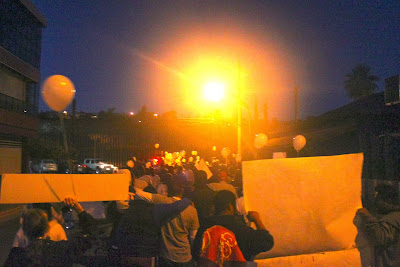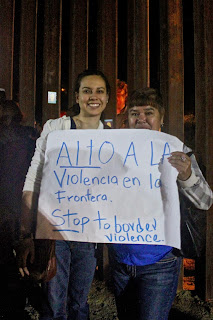First off, some exciting news in the immigration justice world in Tucson: the three Tucson community members who were detained after forcible removal by the Tucson police and Border Patrol have been released on bond! Thank you to all who have been staying up with and supporting this case. Arturo, Agustin, and Rosa are now waiting for news about a potential future court date for their case, but at least they are all back with their families!
And tonight, the Nogales community is seeking a different kind of justice. One year ago today, October 10, 2012, 16-year-old Jose Antonio Elena Rodriguez was shot and killed by U.S. Border Patrol agents across the border wall while he was in Mexico and they were on the U.S. side. Different accounts of that night say Border Patrol was in pursuit of two suspects on the run and Jose Antonio was not the intended target. More frequently the story is that he was throwing rocks, which is a threat to the lives of the agents. Some accounts are a combination. One thing is certain: when you go down to Nogales, Sonora and stand where he was killed, imagine taking a rock and throwing it from fifty feet from the wall and trying to aim over the top of the 20-foot fence. How much of a threat are you? He was just a kid.
It is hard to know the full truth. But to me, at least, the real question is what justifies shooting a 16-year-old at all? What justifies shooting and killing across an international border? What justifies putting eight bullet holes into his body, and leaving several more in the building behind him?
For more about this tragedy and the Border Patrol's use of deadly force, here's a current article: Questions Linger Over Jose Antonio Elena Rodriguez' Death
Additionally, BorderLinks' Nogales sister organization, HEPAC, put together this powerful video. Warning: some sounds and imagery are disturbing, but very powerful. Watch if you can: Campaña: Justicia para Jose Antonio
This kind of justice is very real. The Nogales community has held vigils on the 10th of every month, placing candles around a white cross at the site where he was killed. His mother and the community have rallied to call for an end to Border Patrol acting with complete impunity. There has been no investigation into their actions. His mother simply wants to know who killed her son and how they will be held accountable.
And tonight, on the year anniversary of his death, a few of us from BorderLinks went down to Nogales to show our support for this community still crying out for Jose Antonio. They are still crying out for justice in this singular case. And they are crying out for justice on the border so that no more die at the hands of the Border Patrol or in the grips of the desert.
According to their Facebook page, "the campaign has two objectives:
1. Build through strategy and coordinated actions a movement led by People Power that will take Justice for Jose Antonio, Justice for the victims of Border patrol Abuse and Murder, Justice for borderlands people and put an End to Border Militarization policies.
2. Develop the capacity and political vision for the struggle of the people of Nogales. Increase the leadership of individuals and families of Nogales. Put at the forefront the voices of the people of Nogales."
1. Build through strategy and coordinated actions a movement led by People Power that will take Justice for Jose Antonio, Justice for the victims of Border patrol Abuse and Murder, Justice for borderlands people and put an End to Border Militarization policies.
2. Develop the capacity and political vision for the struggle of the people of Nogales. Increase the leadership of individuals and families of Nogales. Put at the forefront the voices of the people of Nogales."
So tonight, Nancy (BorderLinks office manager), Maddie (BorderLinks'
YAV last year), and I piled into Indira's (BorderLinks'
Education Associate) car for the hour drive south. I unfortunately did not grab any photos of Indira or Maddie, but the four of us were the crew crossing to Nogales,
Sonora, Mexico for the night.
 Meet my colega, my co-worker, Nancy!
She's our office manager at BorderLinks, and my partner in crime in
attempting to do regular five-minute exercise breaks during the workday.
Today over lunch, the office was really quiet with most of our
co-workers on vacation or out for lunch, so we ended up having a really
long conversation, mainly realizing we have a lot in common with our
long-distance relationships. She's such a lovely person (when she's not
being purposefully annoying while I'm trying to nap in the backseat), and I'm thankful to get her know her more as a person through our bonding conversation and time outside of BorderLinks for this event.
Meet my colega, my co-worker, Nancy!
She's our office manager at BorderLinks, and my partner in crime in
attempting to do regular five-minute exercise breaks during the workday.
Today over lunch, the office was really quiet with most of our
co-workers on vacation or out for lunch, so we ended up having a really
long conversation, mainly realizing we have a lot in common with our
long-distance relationships. She's such a lovely person (when she's not
being purposefully annoying while I'm trying to nap in the backseat), and I'm thankful to get her know her more as a person through our bonding conversation and time outside of BorderLinks for this event.Here's what this section of the port of entry looks like:
Since this is a higher traffic time at the port with people going to and from school or work, there are more officers around. I've never had any issue crossing to the Mexican side, but this time, U.S. Border Patrol had a presence and was stopping people at random. Our group of four young women, two Latina and two white, were asked questions like, "Where are you from? How did you get here? How much money do you have?" Tucson, ummm we drove... And, about $5 in cash. Was there a need for this interrogation? Were we supposed to have our guard up when talking to law enforcement on our way out of our country? I definitely was not mentally prepared for that, but apparently we passed.
And then we ran into Shurra! She is one of the Green Valley Samaritans (a humanitarian aid organization of volunteers that bring water, food, and medical supplies out to the desert) that helps take BorderLinks groups on desert walks so see common migration trails and also things that have been left behind by people. I am realizing the immigration justice community feels like a small world sometimes. In any event, Shurra still had to find her other Samaritans, but she walked with us to find the marcha. I was not sure what this event would be like, I just wanted to be there with the community on this tough night, but I think I anticipated more of a vigil than a march through the streets of Nogales.
By the time we got there, people had already been marching a little ways from a plaza in town, and we were all headed to the site of Jose Antonio's death.
HEPAC director Jeannette. When we first met, the second she heard me speak two words in Spanish, she started going a mile a minute! She is one of the sweetest, most energetic people I've ever met, but sometimes it just takes me a second to fully catch up to her. Here she's working her magic.
Press are on the scene.
I never learned why some painted their faces white, but here they are!
Many marchers carried white balloons with them to release into the sky.
MaryCruz, one of BorderLinks' delegation trip leaders from our Nogales sister organization, HEPAC.
People put the Jose Antonio stickers everywhere they could.
Passersby took a look at why we were on the streets, as we chanted slogans such as "Ni una más," not one more, "Abajos los muros de la frontera," down with the border walls, and "El pueblo unido jamás será vencido," the people united will never be defeated.
Members of the "policia turistica," tourist police, followed along with us.
Baby in solidarity!
Turning the corner next to the border wall.
MaryCruz and baby marcher.
Others taking photos of murals on the walls.
Then, the balloons were released into the night sky, little white dots, joining the stars.
Messages on the bank up to the border fence. "¡No más muertes! ¡Justicia!" No more deaths! Justice!
"¡Chinga la migra!" ..... "F--- the Border Patrol!"
Check out this artwork: "We are as free as paper!"
White candles are painted along the Mexico side of the U.S.-Mexico border wall.
The crowd gathering along the wall near where Jose Antonio was shot and killed.
Shurra of the Green Valley Samaritans connecting with supporters on the U.S. side.
Those who had candles shared the flickering flames as community members began speaking about Jose Antonio and how to work towards justice and celebration of his life. A couple even played home-written songs as well. One of the lines: "Jose Antonio, tu vela simpre estará prendida," Jose Antonio, your candle will forever be lit.
Jose Antonio stickers on the border fence and U.S. supporters looking on.
Poster from No More Deaths, a humanitarian aid organization and one of BorderLinks' partners.
Nancy from BorderLinks and MaryCruz from HEPAC!
This is precisely my college major: International Relations! People relating across a physical barrier that divides their two nation-states; here, BorderLinks' Alex on the U.S. side (because he forgot his passport), and MaryCruz and her daughter on the Mexico side. Both in solidarity and support of a grieving Nogales community so hurt by cross-border violence and injustice.
Cross-border high-five.
After the songs and speeches were finished on the Mexico side, they turned to the U.S. side for its voice in the form of Aztec dancers performing - I was not able to get a good picture of the dancers, but here are a few faces on the Mexican side trying to get a good vantage point.
One of the policia turistica officers who had been following the march on his bike actually came closer to watch the Aztec dancers as well. It is amazing how tragedy brings people together.
After their performance was over, we said our goodbyes to our HEPAC brothers and sisters, made it through to the U.S. side of the border uneventfully, and reunited with Alex to take him back in the car with us as well. Before throwing on the Latin tunes for the hour back to Tucson, we were primed with bachata music in the Burger King bathroom. This is life on this border. Cultural duality and intermingling. Conflict and unresolved tension. Despair. Hope. Connection. Flickering candles and crosses in remembrance of lives lost. Resolution to fight for "ni una más" muerte ni deportación, not one more death or deportation.





























































